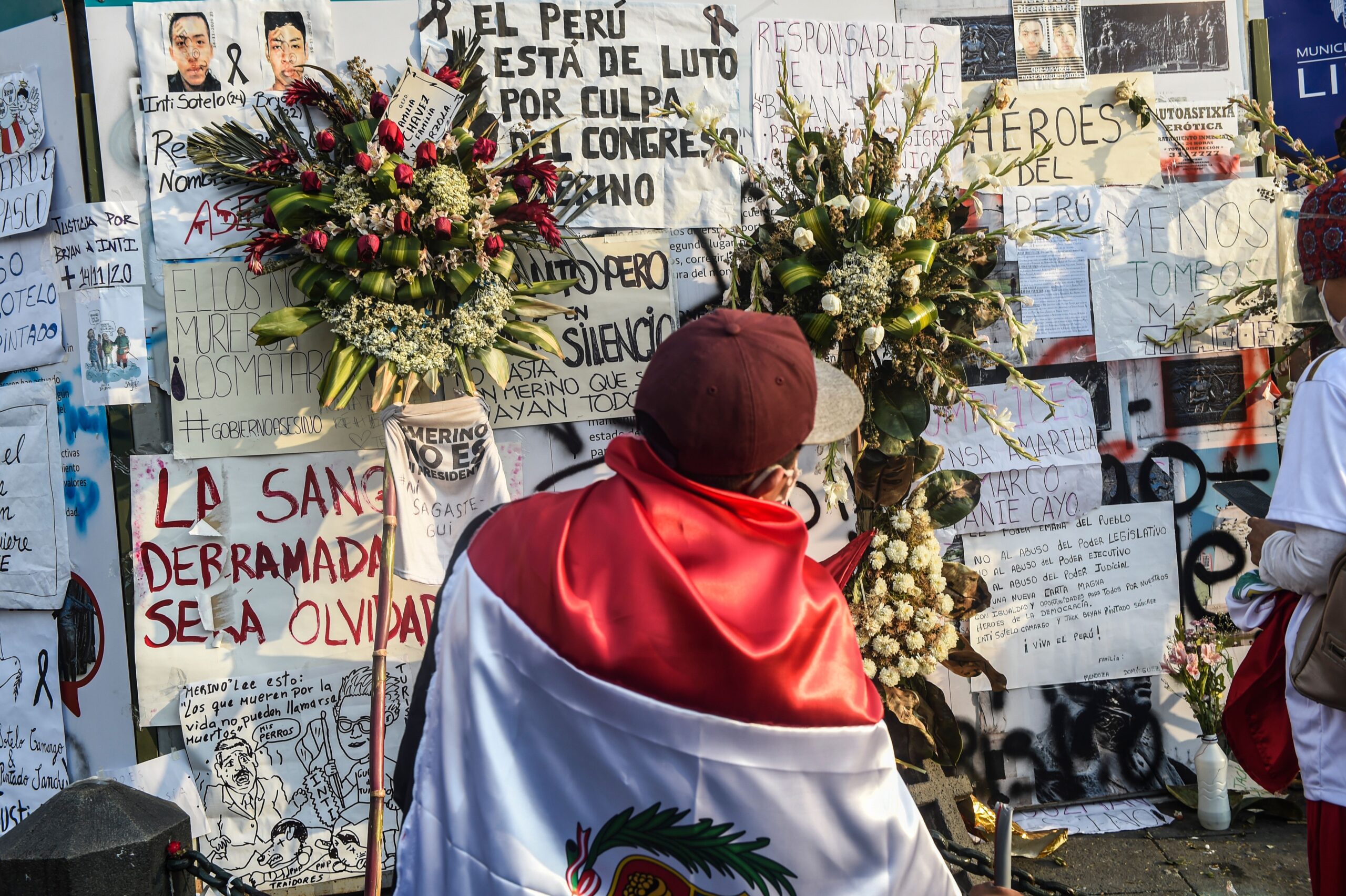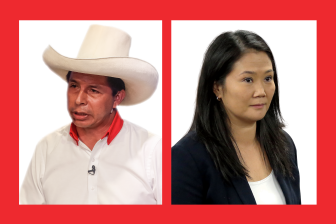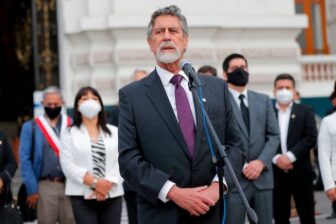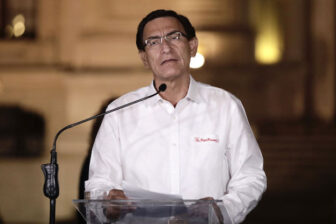LIMA – Last November, Peru’s youth took to the streets in the country’s largest pro-democratic protests since the return to democracy in 2000, accusing lawmakers who voted to remove President Martín Vizcarra of putting corrupt personal interests over the good of the country. A violent police response resulted in the death of two demonstrators, university students Jack Bryan Pintado Sánchez and Inti Sotelo Camargo, as well as hundreds of injuries and arbitrary detentions.
It was in this context that Martha Chávez, a congresswoman belonging to the Fuerza Popular party – led by Keiko Fujimori, the daughter of former authoritarian president Alberto Fujimori (1990-2000) – accused demonstrators of being linked to the terrorist left: “The vandals and extremists, undoubtedly linked to Shining Path or MRTA [Túpac Amaru Revolutionary Movement], who see the protests as the ideal scenario for their crimes, achieved what they wanted from the beginning: deaths!” Chávez tweeted. “This is their excuse to advance their parallel agenda of chaos and attacks on the Forces of Order.”
As absurd as it may seem, this kind of attack is common in Peru, and recently there is even a name for it: terruqueo, the mostly groundless accusation of being connected to once powerful communist terrorist organizations. The term has its roots in the period of violence from 1980 to 2000, initiated by the terrorist group the Shining Path. It was originally used by the peasant communities of Ayacucho, the region in the Peruvian highlands where the armed conflict began, to identify terrorists (terrucos) operating in their region. After the end of the conflict, the term came to be used carelessly and often as a racially charged political insult, targeting progressive or left-wing politicians or activists, organizations committed to the defense of human rights, and, at least historically, people of indigenous origin.
The stigma against the left can be seen in polls as Peru approaches a presidential election in April. Just one leftist is polling above 5%, Verónika Mendoza, who finished third in the 2016 election but has a low ceiling today: Nearly 7 in 10 respondents to the latest Ipsos poll say they “definitely” would not vote for her. But the careless and defamatory use of this political and racial slur is not about any one candidate or party. Nor is it just an insult to the memory of a conflict that caused nearly seventy thousand deaths – it reflects the fragility of Peru’s democracy.
To understand why, it’s important to look at how terruqueo and the fear of the left highlights three deep rifts in Peru’s sociopolitical fabric: the failure of the country’s Truth and Reconciliation Commission to achieve its goals, the widespread lack of trust Peruvians have in their institutions, and the political polarization that fuels an unwillingness to take political opponents seriously.
Peru’s Truth and Reconciliation Commission worked from 2001 to 2003 to investigate the human rights abuses committed during the internal armed conflict. The commission’s final report drew a nuanced picture of the Peruvian left’s romance with, but also its rejection of, terrorism. According to the commission, while the strategy and discourse of most leftist organizations in the 1970s were favorable to seizing power by armed means, many leaders on the left soon took a turn towards supporting electoral means. In fact, while some leaders of the left found it difficult to distance themselves from the violent conceptions of the Shining Path and the MRTA, in other cases they contributed effectively to preventing the advancement of terrorist organizations in their regions.
Fujimori supporters rejected the commission’s report, with some snubbing it without even having read it and arguing that the ex-president had pacified the country and any account that tried to introduce nuance to that narrative had to be combated. Two decades after the end of the armed conflict, an oversimplified image of the left as supporting communist terrorism has persisted. Even artistic efforts to take a critical look at this dark period in Peru’s history continue to be obstructed by censorship. Myriad exhibitions and productions have faced investigations for alleged apology of terrorism.
Furthermore, according to political scientists Alberto Vergara and Daniel Encinas, the internal armed conflict led to a “mutation” of the political right, which united ideologically behind the defense of the neoliberal model enshrined in Fujimori’s 1993 Constitution, and tends to reject and denigrate anyone questioning Peru’s economic model. In this context, accusations of having affinities to chavismo – an affinity with the legacy of Venezuela’s Hugo Chávez – are regularly made to defame left-leaning or leftist politicians.
This failure of the reconciliation process feeds into Peru’s crisis of trust. Data from the Latin American Public Opinion Project (LAPOP) at Vanderbilt University found that, in a region where institutional and inter-personal trust is already low, Peru is one of the countries scoring lowest regarding its citizens trust in congress (36%), political parties (38%), local governments (46%) and even neighbors (47%).
Further, the terruqueo and the enduring stigma against the left fuels Peru’s political polarization and the unwillingness to acknowledge at least the theoretical possibility of not only the faults but virtues of opponents’ positions. It dehumanizes the other and turns him or her into a heartless villain, someone who does not deserve to be listened to or engaged with. Today, supporters of Fuerza Popular are still reluctant to acknowledge that the members of the Armed Forces were responsible for human rights violations, and that the role of the left during the armed conflict was complex.
This year, Peru commemorates its 200th anniversary of independence. It was supposed to be a year of celebration. Instead, during the first wave of the COVID-19 pandemic, the country registered the highest mortality rate in the world, and the Peruvian Central Reserve Bank forecasts a contraction of the GDP of 11.5% for 2020. What is more, according to the LAPOP survey, support for democracy in Peru has been in decline since 2012 (49.3% in 2019) and satisfaction with how democracy functions is very low (28% in 2019).
This is the context in which Peruvians will vote in April. The recent protests have expressed the younger generation’s demand for less corruption and a more consolidated and inclusive democracy, with some even calling for a constitutional assembly to rewrite the 1993 Constitution. For Peru’s conservatives – and many moderates – these demands feed the fire of their fear of the left, as many see the Constitution as the building block of Peru’s economic miracle of the 2000s. Thus, it is likely that the terruqueo will gain new momentum in political campaigns.
Dismissing the demands of growing sectors of the population, and especially a new generation of middle-class students, as chavistas and terrorists, will not achieve the intergenerational consensus required for the reconciliation of country shaken by the pandemic and political and social unrest. In the best case, the young protesters, many born after the end of the period of violence, will brush the insults off. In the worst case, degrading political opponents with false claims of extremism might very well end up radicalizing them.
—
Freier is an associate professor of political science at Peru’s Universidad del Pacífico. Castillo Jara is a research assistant at Universidad del Pacífico.







